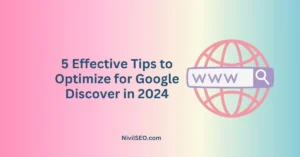In the modern world of internet usage that pervades almost all spheres of our lives, getting as high a rank in the list of search options as possible benefits the site’s owners in achieving their web objectives. Enter SEO, or Search Engine Optimization for short. However, how does one determine the company’s Website standing and identify areas that require adjustment? In 2024, this is your complete action plan for performing an SEO audit packed with step-by-step actions for evaluating and improving your website’s performance.
Why Conduct an SEO Audit?
It is important to know that an SEO audit can be viewed as one large-scale examination of a site’s health. It also analyzes the positives and negatives and highlights areas which may require a lift to increase the sites’ ranking in the search engines and also the consumers’ experience. Scheduling an audit often is a good way to go with the flow expected from the se’s trends and users’ demands change.
How to Analyze and Optimize Your Site: Conducting regular SEO audits is crucial for maintaining and improving your website’s performance.
Step 1:
The first step in the process of search engine optimization involves ensuring that a website is visible to the search engines, or crawlable and indexable.
- Is your web accessible to search engines? To confirm if your site is blocked by a robots, you should engage other tools such as the Google Search Console. such as the Word or txt file or some other technical hindrance.
- Is your sitemap submitted? An XML sitemap is basically a map that helps search engines to locate all and any necessary page on your website. It’s best to submit it to the Google Search Console for this purpose.
Step 2:
Speed Up Your SitePatient is another virtue that can, or rather should, be awaited by search engines.
- Test your website speed. Mobile site performance services like Google PageSpeed Insight simply give out suggestions on how you can improve your site. Start with the efficient putting of images, reducing the number of request that is made and the use of cached systems.
- Every millisecond counts. Users get frustrated with slow websites and such a website is even poorly ranked by the search engine. User’s experience is greatly determined by the time it takes to load the page; try to make the page loading time below 3 seconds.
Step 3:
They third step is Mobile Friendliness – Your Site Needs to be Pocket Sized.
- Mobile devices are used for more than half of all the searches that are conducted. Make sure that you website is mobile friendly or in other words, when you open it in a mobile device, it changes size according to screen’s ability. Another key fact that affect a website’s ranking is Google has a tendency to rank only websites that are mobile friendly.
- Test your mobile-friendliness. These include; The availability and utilization of smartphones has rendered a lot of websites irrelevant through Google’s Mobile-Friendly test.
Step 4:
The fourth step of the process is the Content Audit – Quality Content is King (and Queen).
- Is your content timely? This is because every website requires fresh, useful material that targets the interests and needs of the site’s visitors. Perform the content audit to check the main issues such as outdated material, thin content, and possible absence of a plan.
- Make your content easier to find by search engines. Include relevant keywords in your content and do not overstuff them through the content. But on the other hand, always focus on how the reader will receive the content you are going to provide, and create content that is not only good to read, but stuffed with keywords.
Step 5:
On-Page SEO : To set the ground on a good website.
- The first aspect of title tags and meta descriptions are pretty much your first impression. This you achieve by creating good title tags and meta descriptions that closely relate with the content you post and use to invite users to click.
- Header tags help in organizing the content you have. Always use The H1, the H2, and the H3 tags to make the text more readable and to indicate the structure to the search engines.
Step 6:
Technical SEO ‘The Plumbing behind the beautiful House’
- If links are broken, the user and search engines are left stranded; it is not a good situation to be in. Some equipment that you can use to effectively diagnose and handle bad links include Screaming Frog. This is because a well maintained website is one that will always reel in a positive experience to the users.
- Internal linking is like mapping the tenet of your web domain so that anyone who navigates in it successfully gets the information they are seeking. Connect internal pages to relevant internal pages to help a user go further into your content and enhance website usability for both the user and search engine.
Step 7:
seo | backlinks analysis | Establishing Credibility in the World Wide Web
- Links, or backlinks as they are called are a form of votes that other web pages make to your page. High quality backlinks assure the search engines that your site is worthy of trust and can be relied on.
- Monitor your backlinks. You should use ahrefs.com or semrush.com to analyze the quality of your backlinks. Refute irrelevant links as this may be a threat to your SEO rank.
Step 8:
The point is about User Experience (UX) – happy users are loyal users.
- This means the experience that users have while interacting with your site, their feelings. Is it easy to locate what you want? Is the main concept of the design obvious and easy to understand? This implies that a positive user experience will see the users engaging the site longer and performing a conversion.
- Have your website designed in a way that is compatible with most of the mobile devices. Consequently, users interacting with the sites on mobile devices expect it to be smooth-sailing. It is crucial that a website does not take quite long to load, buttons are easily click-able, and information well provided.
Step 9:
Track Your Progress – SEO is a Marathon, Not a Sprint
- Set up analytics tools like Google Analytics. Monitor key metrics like organic traffic, bounce rate, and conversion rate to track your website’s performance and measure the success of your SEO efforts.
- Stay updated on SEO trends. Search engine algorithms change regularly. Stay informed about the latest updates and adjust your SEO strategy accordingly.
Bonus Tip: Embrace Freshness
Search engines value fresh, informative content. Regularly update your existing content with new information and insights. Consider creating new content that addresses trending topics in your industry.
Remember: SEO is an ongoing process. By conducting regular audits and implementing these actionable steps, you can elevate your website’s ranking, attract more organic traffic, and achieve your online goals.
Additional Resources:
Here are some handy tools and resources to help you with your SEO audit:
- Google Search Console: https://search.google.com/search-console/about (Free tool for website analysis and indexing)
- Google PageSpeed Insights: https://developers.google.com/speed (Free tool to test and improve website speed)
- Google’s Mobile-Friendly Test: https://blog.google/outreach-initiatives/small-business/test-your-site-with-google-and-see-how/ (Free tool to check your website’s mobile-friendliness)
- Screaming Frog: https://www.screamingfrog.co.uk/seo-spider/ (Paid tool for technical SEO audits)
- Ahrefs: https://ahrefs.com/ (Paid tool for backlink analysis and competitor research)
- SEMrush: https://www.semrush.com/ (Paid tool for SEO, PPC, and social media marketing)
- Google Analytics: https://analytics.google.com/analytics/academy/course/6 (Free tool for website traffic analysis)
Taking the Next Step
Don’t feel overwhelmed! Start small and focus on one or two areas at a time. As you implement these steps and analyze the results, you’ll gain a deeper understanding of your website’s strengths and weaknesses. Remember, SEO is a journey, not a destination. By consistently optimizing your website, you’ll attract more visitors, improve brand awareness, and ultimately achieve your online goals.Consulting with an SEO expert Dubai can provide you with professional insights and strategies tailored to your specific needs and market.
Feel free to adapt this guide to your specific needs. Research industry-specific SEO best practices for additional insights. By putting in the effort and staying informed, you can turn your website into a powerful online marketing tool.










